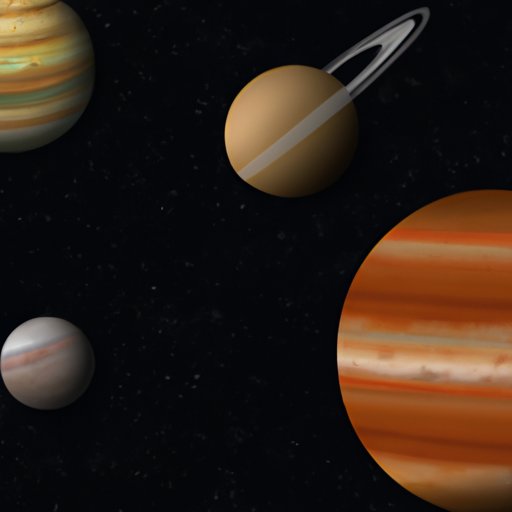Introduction
When we think about the planets in our solar system, we often group them into two categories: rocky, terrestrial planets, and gas giants. But what exactly does it mean for a planet to be terrestrial? And how does this differ from the gas giants that we’re more familiar with, like Jupiter and Saturn?
In this article, we’ll explore the different characteristics that define terrestrial planets, which planets in our solar system fall into this category, and why studying these rocky worlds is crucial for understanding planetary formation, evolution, and the quest for extraterrestrial life.
Exploring the Characteristics of Terrestrial Planets in Our Solar System: What Makes Them Different from Gas Giants?
The four planets closest to the sun—Mercury, Venus, Earth, and Mars—are all considered terrestrial planets. Unlike the gas giants, these rocky worlds are relatively small, with solid, compact surfaces.
One of the key differences between terrestrial planets and gas giants is their composition. Terrestrial planets are made up primarily of rock and metal, with a much smaller proportion of gases like nitrogen and oxygen. Gas giant planets, on the other hand, are mostly composed of hydrogen and helium, with relatively small amounts of rock and metal.
Another major difference between these two types of planets is their distance from the sun. Terrestrial planets are located closer to the sun and have much shorter orbital periods, meaning they take less time to make a complete orbit around the sun. This proximity to the sun also means that terrestrial planets have higher surface temperatures than the gas giants.
Terrestrial vs. Jovian Planets: Why Earth and Its Rocky Neighbors are More Similar Than You Think
Near the outer edge of the solar system, we find the gas giants: Jupiter, Saturn, Uranus, and Neptune. These planets are often lumped together as “jovian” (meaning Jupiter-like) planets, as they share many similar characteristics.
However, Earth and its rocky neighbors are actually more similar to each other than to the gas giants. All of the terrestrial planets share a rocky composition and relatively thin atmosphere, and are much smaller than the gas giants.
Understanding these similarities is important for gaining insights into the evolution and formation of planets. By comparing and contrasting the different types of planets in our solar system, scientists can better understand what conditions are necessary for the formation and evolution of planets, both in our solar system and in other star systems throughout the universe.
What Makes a Planet Terrestrial? Breaking Down the Science Behind Rocky Worlds
So far, we’ve discussed some of the basic characteristics that define terrestrial planets, but how do scientists actually determine whether a planet is terrestrial or not?
Generally speaking, scientists use a combination of observations and modeling to determine a planet’s composition, density, and other key properties. For example, astronomers can study a planet’s size and mass by observing how it affects the motion of other objects in its vicinity, such as its moons or nearby asteroids.
One of the defining characteristics of terrestrial planets is their geological activity. Terrestrial worlds have active volcanoes, tectonic activity, and other geological processes that shape their landscapes over time.
However, there is still much we don’t know about these rocky worlds. For example, recent research has suggested that Mars may have once had a more active geology than previously thought, which could have important implications for the history of the Martian climate and the potential for life on the planet.
Searching for Life Beyond Earth: Why Studying Terrestrial Planets is Crucial in the Quest for Extraterrestrial Life
One of the most exciting areas of research in planetary science is the search for extraterrestrial life. While much of this work involves studying the potential habitability of exoplanets orbiting other stars, there are also places within our own solar system where scientists believe life could exist or have existed.
One of the key factors in determining whether a planet is habitable is its location within the habitable zone of its star. This is the region around a star where the temperature is just right to allow liquid water to exist on a planet’s surface. Earth is located within the habitable zone of the sun, as are some of the other terrestrial planets in our solar system.
Scientists also believe that some of the icy moons orbiting the gas giant planets could have subsurface oceans of liquid water, which could potentially harbor life. Studying terrestrial planets like Mars and Venus can help us understand the conditions necessary for life to exist, which can in turn inform our search for life elsewhere in the universe.
The Rocky Road to Understanding Terrestrial Planets: Unpacking the Latest Discoveries in Planetary Science
In recent years, there have been many exciting discoveries and breakthroughs in the study of terrestrial planets. For example, the Mars Curiosity rover has provided us with unprecedented up-close views of the Red Planet’s geology and atmosphere, while the Kepler Space Telescope has detected thousands of exoplanets orbiting other stars.
Despite these advances, there is still much we don’t know about terrestrial planets. For example, the origin of Earth’s water remains a mystery, and there is ongoing debate about whether Mars ever had a more Earth-like climate.
As new missions and telescopes continue to explore our solar system and beyond, we can expect to learn many more fascinating things about rocky worlds and the secrets they hold.
Conclusion
In conclusion, terrestrial planets are a fascinating subject of study that have much to teach us about the formation and evolution of planets, the potential for extraterrestrial life, and the mysteries of the universe. By exploring the key characteristics of these rocky worlds and understanding their similarities and differences from gas giant planets, we can gain a deeper appreciation for the complexity and diversity of the solar system and beyond.
We hope this article has helped you better understand what makes a planet terrestrial and given you some insight into the ongoing research in planetary science.
